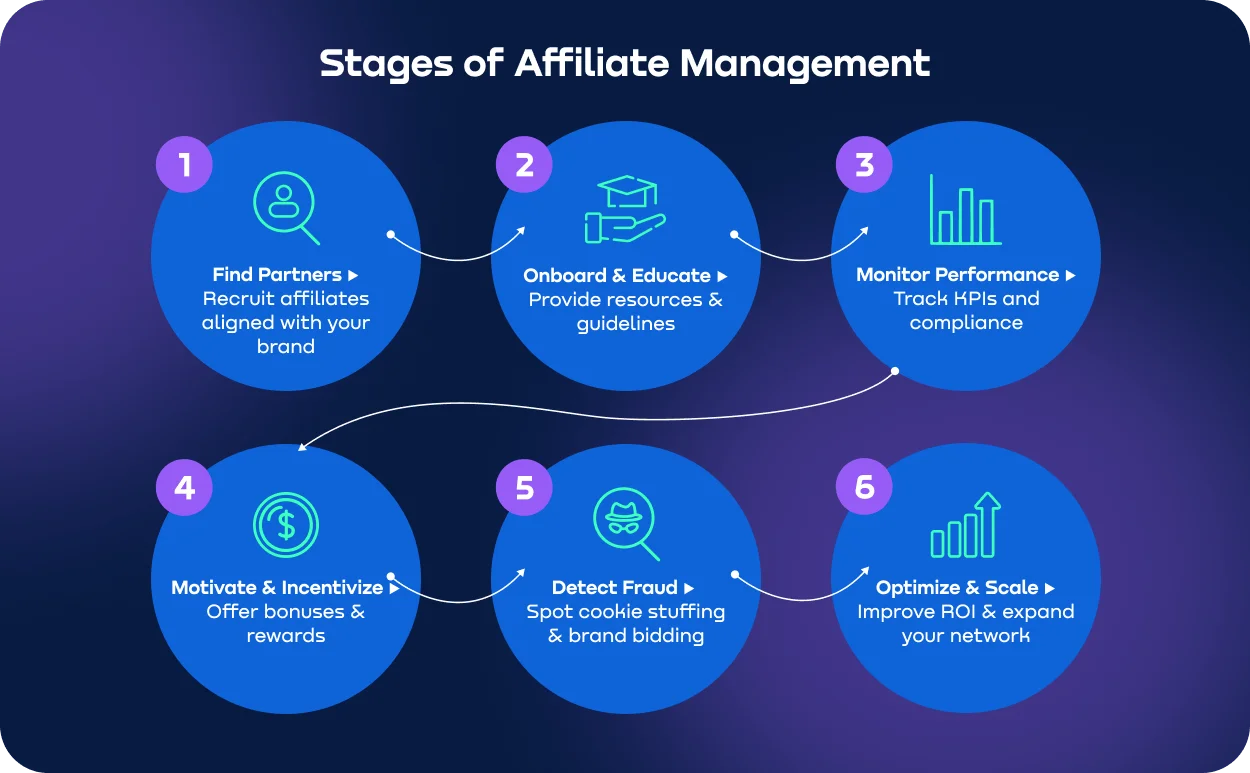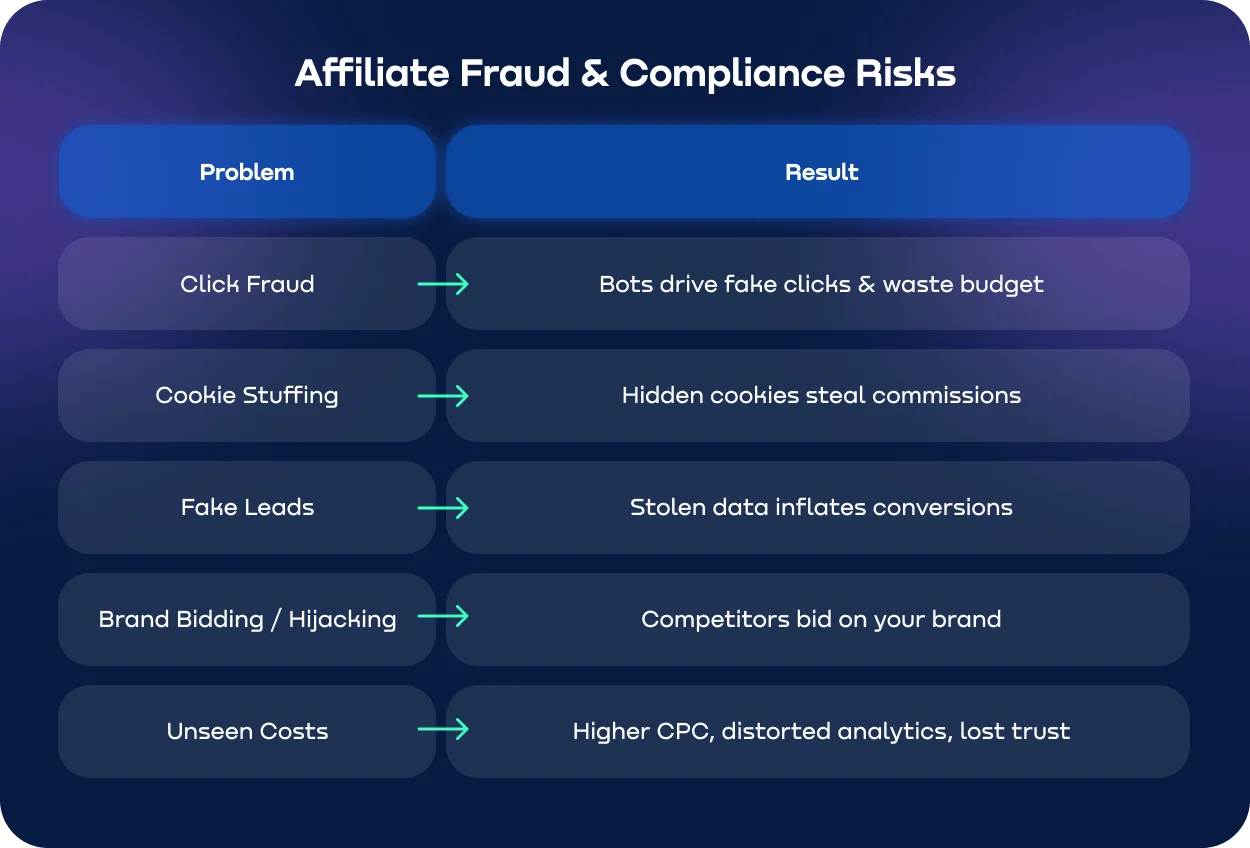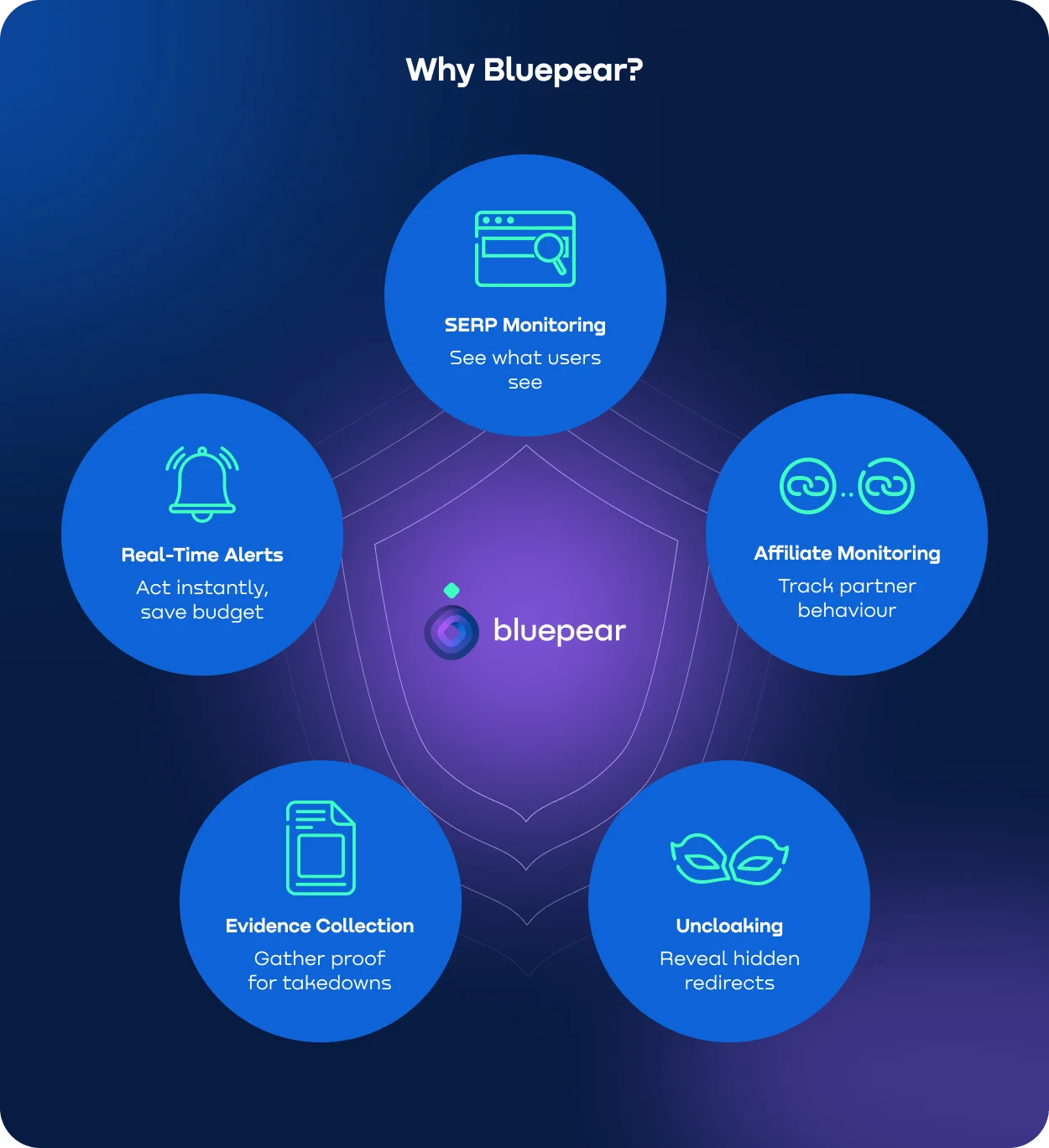
Contents
Affiliate marketing management has become one of the most efficient ways for companies across e-commerce, fintech, SaaS, insurance, and travel to scale customer acquisition. By partnering with affiliates, brands can tap into new audiences, pay only for measurable results, and build predictable revenue streams.
But launching an affiliate program is not enough. The difference between a profitable partnership ecosystem and a cost-draining channel lies in affiliate program management — the set of processes that cover recruitment, onboarding, communication, performance tracking, and fraud prevention.
When managed well, affiliate programs can drive consistent growth and deliver some of the highest ROAS among digital channels. When left unmanaged, they open the door to low-quality traffic, compliance risks, and fraud schemes that can quietly erode margins.
In today’s competitive landscape, affiliate program management is no longer just about acquiring partners. It’s about building structured processes, automating partner program compliance checks, and staying one step ahead of fraudsters. In this article, we’ll explore the fundamentals of affiliate program management, common fraud risks to watch out for, and a step-by-step guide to building a robust, compliant, and scalable program. We’ll also look at affiliate management software and how automated solutions and tools like Bluepear empower managers to protect ROI and drive sustainable growth.
What is Affiliate Program Management?
Affiliate program management refers to the end-to-end process of building, running, and optimizing an affiliate program. It goes far beyond setting up tracking links or publishing commission rates. Effective affiliate marketing management ensures that affiliates are recruited strategically, motivated to perform, monitored for compliance, and rewarded fairly.
At its core, affiliate program management combines three pillars:
- • Recruitment – identifying and onboarding affiliates who align with the brand’s goals.
- • Enablement – providing partners with creative assets, training, and ongoing communication.
- • Optimization & Compliance – tracking KPIs, preventing fraud, and maximizing ROI.
Affiliates themselves typically fall into three categories:
- • Unattached affiliates – marketers who have no direct connection to the product or service and usually run campaigns purely on paid traffic. They can generate significant reach but often require stricter compliance oversight.
- • Related affiliates – individuals or businesses with some link to the niche. Their audiences are relevant, and their content helps create credibility for the brand.
- • Involved affiliates – partners who actively use and advocate for the product. Involved affiliates often build the strongest trust with audiences and deliver the highest-quality traffic, making them invaluable to long-term growth.
Managing these diverse groups requires different approaches and reliable affiliate management software. An unattached affiliate may need stricter compliance oversight, while an involved affiliate thrives with deeper collaboration and exclusive incentives.
In most companies, the affiliate manager or program director plays a central role. This position is responsible for:
- • Defining commission structures and promotional rules.
- • Recruiting and vetting affiliates.
- • Coordinating with legal and compliance teams.
- • Monitoring performance data and detecting anomalies.
- • Acting as the main point of contact between the brand and its partners.
In short, affiliate program management ensures that partnerships remain profitable, brand-safe, and aligned with long-term business objectives.

Challenges & Risks: Fraud and Compliance
While affiliate marketing remains one of the most performance-driven channels, it also attracts some of the most sophisticated forms of digital fraud. According to industry estimates, ad fraud costs businesses more than $84 billion annually, and affiliate programs are a prime target due to their performance-based payout models.
Fraudulent affiliates exploit gaps in tracking and oversight if you don’t use affiliate management automated solutions. Some of the most common schemes include the following traps.
Click fraud
Fraudsters generate massive volumes of fake clicks, often using automated bots, scripts, or organized click farms. The goal is to manipulate click-through rates (CTR), drain advertising budgets, and inflate performance metrics to create a false appearance of legitimacy. On the surface, traffic numbers rise, but conversions and revenue do not follow.
Cookie stuffing
Secretly dropping tracking cookies on a user’s browser without their knowledge, unfortunately, works. For example, a user might visit a completely unrelated website, and through hidden scripts, an affiliate cookie is placed on their device. If the user later makes a purchase directly from the brand — without ever interacting with the affiliate — the fraudster still gets credit for the sale.
Fake leads
Fraudulent affiliates use automated form fillers, stolen personal data, or low-quality incentivized traffic to create leads that pass initial validation checks but never convert into real customers. In sectors like fintech, insurance, or SaaS, these fake leads can also introduce compliance risks, since companies may inadvertently store or process fraudulent or even stolen information.
Brand bidding and ad hijacking
In brand bidding, affiliates target a company’s own branded keywords — for example, bidding on “BrandName + official site” — and intercept users who were already searching for the company. Ad hijacking takes this a step further: affiliates mimic the brand’s ads, using identical copy or display URLs, so users cannot distinguish between the legitimate ad and the fraudulent one. In both cases, the affiliate effectively steals traffic the brand would have acquired organically, while inflating commission payouts.
What makes these attacks even harder to detect today is the use of AI and cloaking tactics. Fraudsters increasingly rely on machine learning to mimic real user behavior, while techniques like typosquatting, domain spoofing, and geo-targeted cloaking allow them to disguise their activity and avoid standard manual reviews.
The challenge for affiliate managers is scale: a single program may have hundreds of affiliates and thousands of campaigns running across geographies. Manual checks are no longer sufficient — affiliate fraud detection and compliance monitoring must be automated to keep pace with evolving threats. It highlights the need to have affiliate management software.

Building a Robust Affiliate Program
Launching an affiliate program is only the first step. To turn it into a sustainable and profitable growth channel, brands need a structured framework for selecting partners, defining incentives, enabling performance, and continuously monitoring results with affiliate management solutions.
Step 1: Choose the right partners
Not all affiliates bring equal value, so selection should be based on clear criteria. Influence and reach matter, but so do proactivity and motivation. Affiliates who test and optimize campaigns, rather than taking a passive approach, are more likely to deliver long-term results. Just as important is brand alignment — the partner’s content and communication style should reflect the company’s values to avoid reputational risks.
Step 2: Design a fair commission model
Once partners are identified, the next priority is designing a fair commission model. Commission structures must balance attractiveness for affiliates with sustainability for the business. Depending on the product and sales cycle, brands may choose RevShare, CPA, or hybrid models. Tiered bonuses can encourage participants of an affiliate management system to scale their performance, while higher payouts for high-quality traffic help align incentives. At the same time, clear rules must define disallowed practices such as brand bidding or incentivized traffic.
Step 3: Equip affiliates with strong marketing assets
To enable performance, affiliates should be equipped with strong marketing assets. Providing ready-to-use creatives, brand guidelines, product feeds, and tracking links reduces friction and allows partners to launch campaigns quickly. Well-prepared materials not only accelerate scaling but also ensure that messaging remains consistent with brand standards.
Step 4: Build strong communication
Strong communication is another critical component. Affiliate programs thrive on transparency and trust, which can only be built through regular interaction. Onboarding sessions, training calls, and monthly newsletters help keep affiliates informed and engaged. For top-performing partners, dedicated account managers ensure personalized support and faster issue resolution.
Step 5: Continuously measure and optimize
Finally, continuous measurement is essential to keep the affiliate management system on track. Key performance indicators such as revenue, conversion rate, average order value (AOV), commission percentage, ROI, and fraud rate provide a holistic view of performance. Tracking these metrics makes it easier to identify top affiliates, detect anomalies, and adjust strategies to maximize profitability. Here, you meet the need for affiliate management software.
A robust affiliate marketing management is built on careful partner selection, transparent incentives, ongoing enablement, and data-driven optimization. With these foundations in place, companies can ensure their programs remain both profitable and brand-safe.
Automation & Compliance
As affiliate programs scale, manual affiliate marketing management quickly becomes unsustainable. A program with hundreds of partners and thousands of campaigns across multiple geographies cannot rely on spreadsheets or ad-hoc checks. This is where affiliate program management platforms play a critical role. They provide a centralized affiliate management system to track performance, manage payouts, customize commission models, and integrate with existing marketing stacks.
Modern affiliate management solutions also bring AI-powered fraud detection, capable of identifying patterns that human managers may overlook. Unlike standard checks, which can only flag anomalies after damage is done, automated platforms continuously monitor campaigns in real time, helping companies stay ahead of fraudsters.
One example is Bluepear, a compliance and monitoring tool designed specifically for affiliate and paid search programs. This affiliate management software scans search engine results pages (SERPs) to detect brand bidding and ad hijacking, identifies tactics like cookie stuffing and typosquatting, and uses uncloaking technology to reveal hidden redirects. Beyond detection, it also collects evidence, generates detailed reports, and sends instant alerts to program managers, making enforcement faster and more reliable.
By combining centralized affiliate marketing management, advanced integrations, and automated fraud prevention, affiliate managers gain both control and scalability. Instead of reacting to issues after revenue is lost, they can run programs with confidence, ensuring compliance and profitability at every stage.

Case Study
To illustrate how automation and software transform affiliate program management, let’s look at a case where Bluepear was deployed by a global e-commerce brand facing recurring brand bidding and fraudulent leads. Despite a well-structured program, the company noticed unusually high commission payouts paired with a declining ROI. Manual reviews revealed only fragments of the problem — many violations remained invisible due to cloaking and geo-targeted campaigns.
After implementing Bluepear, the brand gained real-time visibility into its affiliate management system. The platform identified affiliates using cookie stuffing and brand bidding on trademarked keywords, while also uncovering typosquatting domains redirecting users through hidden links. Each violation was documented with screenshots and timestamped evidence, which allowed the compliance team to take immediate action. Within three months, the company reduced fraudulent traffic by more than 30% and reallocated budgets toward high-value affiliates, improving overall program ROI.
Action Plan
For companies looking to strengthen their affiliate marketing management, the following action plan provides a clear roadmap:
- • Select partners carefully – vet affiliates for reputation, relevance, and alignment with your brand.
- • Define clear policies – set transparent rules on commissions, traffic sources, and disallowed practices.
- • Enable monitoring – implement automated affiliate management solutions to track SERPs, detect fraud, and collect evidence.
- • Respond to violations – act swiftly by warning, suspending, or removing fraudulent affiliates.
- • Motivate top performers – reward compliant affiliates with higher rates, bonuses, or exclusive promotions.
This combination of strategic partner selection and automated monitoring ensures that affiliate marketing management remains profitable and brand-safe.
Summing up
Affiliate marketing management continues to be one of the most cost-efficient and scalable growth channels for brands across industries. But success requires a clear strategy. Effective affiliate program management is built on three pillars: a thoughtful strategy for partner recruitment and motivation, automation to handle operations at scale, and continuous compliance monitoring to protect the brand. If your brand is looking to strengthen its program, now is the right time to explore affiliate management software. Bluepear enables affiliate managers to monitor SERPs, uncover fraud schemes such as cookie stuffing, typosquatting, and brand bidding, and act on violations with documented evidence. By centralizing affiliate marketing management and automating detection, you gain the control needed to grow with confidence.
Test Bluepear today to see how automation and compliance can transform your affiliate program into a secure and profitable growth channel.
FAQ
How do I choose the right affiliates?
Start with alignment. The best affiliates are those whose audience overlaps with your target market and whose promotional style matches your brand values. Evaluate their traffic sources, engagement rates, and reputation before onboarding. Avoid affiliates with a history of compliance issues, and always define clear policies from day one and build your affiliate management system.
What metrics matter most in affiliate marketing management?
While revenue is the ultimate goal, you should monitor supporting KPIs to get the full picture: conversion rate (CR), average order value (AOV), ROI, commission percentage, and fraud rate. Tracking these together helps you identify high-value affiliates, optimize payouts, and spot anomalies early.
How often should I audit my program following the rules of productive affiliate marketing management?
Affiliate programs should be monitored continuously, not just quarterly. Fraudsters adapt quickly, often switching tactics by geography or time zone. Automated compliance tools provide real-time oversight, but managers should also schedule regular manual reviews to reinforce accountability and relationship-building.
How can I detect fake websites with affiliate management software?
Look for signals such as typosquatting (domains that mimic your brand with slight misspellings), domain spoofing, and cloaked redirects. Manual detection is difficult at scale, which is why affiliate tracking platforms like Bluepear monitor SERPs, uncloak hidden redirects, and provide timestamped evidence of violations.
How does PPC fraud protection in affiliate management solutions work?
PPC fraud protection tools track branded keyword bidding and ad hijacking in search results. They detect affiliates or competitors who try to intercept users searching for your brand, often by disguising landing pages. By flagging these violations, collecting proof, and sending alerts, managers can stop revenue leakage and protect ROI and your affiliate management system.

